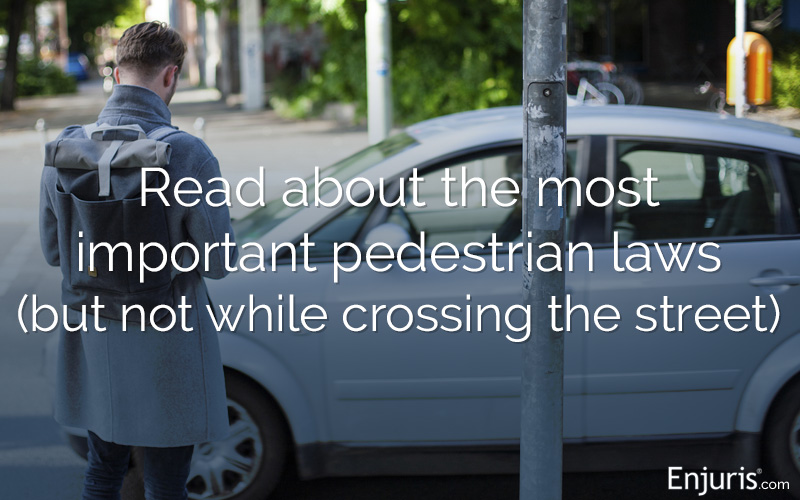
Who’s to blame when a car and a pedestrian collide?
You’re leaving the Birmingham Museum of Art on foot. You stop at an intersection to read an incoming text. You don’t see any cars out of the corners of your eyes so you step into the crosswalk and...
BOOM!
You’re struck by a car.
Who’s to blame for your accident? And if you’re partially at fault, can you still recover damages?
In this article, we’ll look at pedestrian accidents in Alabama, including the laws that impact pedestrians and how fault is determined.
Pedestrian accident statistics
We spend a lot of time talking about car accidents on Enjuris, but pedestrian accidents have risen an astonishing 81% since 2010.
Data from the Governors Highway Safety Association (GHSA) projects that 2020 had the largest ever annual increase in the rate at which drivers struck and killed people on foot.
Experts believe the increase in pedestrian accidents can largely be attributed to distracted walking (for example, pedestrians walking while texting or talking on the phone).
What’s more, Alabama is the 9th most dangerous state for pedestrians with a pedestrian fatality rate of 2.43 per 100,000 people (the national average is 1.89).
| Alabama pedestrian accidents (2015-2019) | |||
|---|---|---|---|
| Year | Pedestrians | Injuries | Fatalities |
| 2015 | 834 | 656 | 96 |
| 2016 | 932 | 724 | 122 |
| 2017 | 882 | 706 | 113 |
| 2018 | 861 | 691 | 106 |
| 2019 | 905 | 713 | 114 |
| Source: Alabama Department of Transportation | |||
Alabama laws that impact pedestrians
Just like motor vehicle drivers, pedestrians are required to obey certain laws while navigating Alabama’s roads and sidewalks.
Most of the laws that impact pedestrians can be found in Alabama Code Section 32-5A. Here are some of the highlights:
| Law | Statute |
|---|---|
| A pedestrian must obey all traffic-control devices. | Alabama Code 32-5A-210 |
| A driver must yield the right of way to a pedestrian crossing the roadway within a crosswalk. | Alabama Code 32-5A-211(a) |
| A pedestrian crossing a road at any point other than within a marked crosswalk or within an unmarked crosswalk at an intersection must yield the right-of-way to all vehicles. | Alabama Code 32-5A-212 |
| A pedestrian must not suddenly leave a curb or other place of safety and walk or run into the path of a vehicle. | Alabama Code 32-5A-211(b) |
| A driver must exercise due care to avoid colliding with any pedestrian. | Alabama Code 32-5A-213 |
| A driver must yield the right-of-way to any pedestrian on the sidewalk. | Alabama Code 32-5A-218 |
| A pedestrian must not walk on an adjacent roadway when a sidewalk is provided. | Alabama Code 32-5A-215 |
| A pedestrian is prohibited from hitchhiking. | Alabama Code 32-5A-216 |
| A pedestrian who is under the influence of alcohol or any drug to a degree that renders them a hazard must not walk or be upon a highway. | Alabama Code 32-5A-221 |
Determining fault in an Alabama pedestrian accident
To prove fault (and recover damages) after a pedestrian accident, the pedestrian needs to prove that someone else was “at fault” for the accident. Parties that may be at fault for a pedestrian accident include:
- Motor vehicle drivers. Motor vehicle drivers have a duty to obey all traffic laws and exercise “reasonable care” when navigating Alabama’s roads. If a motor vehicle driver, for example, fails to stop at a crosswalk and hits a pedestrian, they may be at fault for the accident.
- Bicyclists. Bicyclists also have a duty to obey all traffic laws and exercise reasonable care when navigating Alabama’s roads. If a bicyclist, for example, hops on the sidewalk and runs into a pedestrian, they may be at fault for the accident.
- Property owners. Under Alabama’s premises liability laws, property owners typically have a duty to keep their properties in a safe condition. A property owner (often a local municipality) might be at fault for a pedestrian accident if they fail to keep their property in a safe condition by, for example, failing to maintain a sidewalk.
To prove that 1 of the above parties was at fault, the pedestrian typically needs to establish the elements of negligence:
- The defendant owed the pedestrian a duty to exercise reasonable care,
- The defendant breached the duty to exercise reasonable care, and
- The defendant’s breach caused the pedestrian’s injury.
Some pedestrian accidents are caused (or at least partially caused by) the pedestrians themselves.
Alabama adopted the pure contributory negligence rule to deal with shared fault. This rule says that, even if the injured party (the pedestrian) was 1% at fault for the accident, the injured party is prohibited from recovering any damages.
Let’s take a look at an example:
At the same time, Charlotte was driving her pickup north on Old Pine Road. In addition to being intoxicated, Charlotte was texting while driving. As a result, Charlotte didn’t see Mason walking along the side of the road and hit him with her pickup.
Mason suffered a broken leg and sued Charlotte for $500,000.
After a 3-day trial, the jury found that Charlotte was 95% at fault for the accident (for driving under the influence and texting while driving) and that Mason was 5% at fault for the accident (for failing to use the sidewalk).
Under Alabama’s pure contributory negligence rule, Mason is prohibited from recovering any damages even though he was only 5% at fault for the accident.
Types of damages available in an Alabama pedestrian accident
As you might imagine, when a vehicle collides with a pedestrian, the pedestrian typically suffers the brunt of the damage.
The severity of a pedestrian’s injuries depends on a number of factors, including the vehicle’s speed, the angle of impact of the vehicle upon the pedestrian, the center of gravity of the pedestrian, the part of the body that first comes into contact with the vehicle, and the vehicle design.
According to an article published in the California Journal of Emergency Medicine, the most common injuries seen in pedestrian collisions include:
- Traumatic brain injuries (TBI)
- Musculoskeletal injuries (particularly the upper and lower legs)
- Chest injuries
- Abdominal injuries
Fortunately, Alabama allows pedestrians to recover 3 types of damages:
- Economic damages represent the monetary losses caused by a pedestrian accident (for example, medical expenses, lost wages, and property damage).
- Non-economic damages represent the non-monetary losses caused by a pedestrian accident (for example, pain and suffering).
- Punitive damages are intended to punish the defendant and are only available in cases in which the defendant acted intentionally.
How does insurance work in a pedestrian accident?
All drivers in Alabama are required by law to carry liability insurance. Specifically, drivers are required to carry the following minimum liability insurance:
- $25,000 for bodily injury liability per person injured in an accident
- $50,000 for total bodily injury liability when 2 or more people are injured in an accident, and
- $25,000 for property damage per accident.
This means that, if a pedestrian is hit by a vehicle, the pedestrian can make a claim against the driver’s liability insurance policy (assuming the driver was at fault). If the damages exceed the driver’s policy limits, the pedestrian will need to file a personal injury lawsuit against the driver to recover any amount above the limits.
If the driver is uninsured, then the pedestrian's uninsured motorist coverage (or MedPay insurance) will usually compensate the pedestrian for their losses (assuming the pedestrian has these optional coverages).
How long do I have to file a pedestrian accident lawsuit in Alabama?
Like all states, Alabama limits the amount of time you have to file a lawsuit. This time limitation is called the “statute of limitations.”
In Alabama, you typically have 2 years from the date of the accident to file your lawsuit.
Tips to avoid a pedestrian accident
At Enjuris, we like to provide guidance if you need to file an insurance claim or lawsuit after an accident. However, our hope is that you can avoid getting into an accident altogether.
Here are 4 pedestrian safety tips from the Centers for Disease Control and Prevention:
- Increase your visibility at night by carrying a flashlight when walking and wearing reflective clothing, such as reflective vests.
- Cross streets at a designated crosswalk or intersection whenever possible.
- Walk on a sidewalk or path instead of the road. Walk on the shoulder and face traffic if a sidewalk or path is not available.
- Avoid using electronic devices like earbuds or walking if you have been using alcohol or drugs. They can cause distractions and impair judgment and coordination.
If you’ve been injured in a pedestrian accident, an attorney can help take you through your legal options. Find an experienced Alabama personal injury attorney near you in our free online directory.
See our guide Choosing a personal injury attorney.

